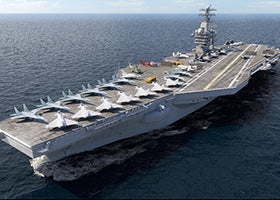
In the last few decades, the United States Navy has opened the door to upgrades and advancements in Artificial Intelligence (AI) technology for its ship systems, command and control infrastructure and decision-making capabilities. The Naval Research Laboratory established the Navy Center for Applied Research in Artificial Intelligence in 1981, and has been in the forefront of emerging technologies for Artificial Intelligence Machine Learning (AI/ML) applications for the United States Navy. These AI technologies are particularly found in two main areas: autonomous/unmanned systems and decision sciences.
These emphasize AI/ML for research and development for deployment, operational efficiency, threat detections and safety. Many of these areas face a critical need for ruggedized high performance (HPC) servers, expansion systems and edge transportable applications. One Stop Systems (OSS) AI transportables for defense provides state of the art solutions for the US Navy to address their AI/ML requirements.
Autonomous/Unmanned Systems
The US Military deploys autonomous/unmanned technology for aerial, land vehicles and ISR applications. There are endless applications for autonomous vehicles in military and defense. Consequently, the United States Navy has expanded its capabilities to unmanned surface vessels (USV’s) and unmanned undersea vessels (UUV’s). The demand for AI Transportable technology will increase substantially in the years to come.
The Chief of US Naval Operations has recently released the US Naval Operations Navigation Plan 2022, which calls for 373 manned ships and 150 unmanned ships, for a total of 523 ships by the year 2045. In other words, it is anticipated that more than 1/3 of all US Navy ships will be unmanned and autonomous by the year 2045.
The primary US Navy unmanned drone ships are unmanned surface vessels (USV’s) and unmanned undersea vessels (UUV’s). These unmanned drone ships will have surface and subsurface platforms to conduct intelligence, surveillance and reconnaissance (ISR), electronic warfare systems and strike capability to keep sailors safe.
In the National Defense article Surface Navy Building Digital Infrastructure to Harness AI, it discusses how the US Navy's unmanned surface and undersea vehicles have many critical components to win conflicts in defense. One of these is the recent critical components of the new Naval Sea Systems Command (NAVSEA) Condition Based Maintenance Plus Initiative which “Once Operational, the capability will leverage AI and ML to sort through a ship’s data and use predictive analytics to identify issues with systems and subsystems that need to be addressed to preempt problems at sea.”
One Stop Systems' solutions to meet these challenges include the 3U SDS Server. This server is ideal for edge transportation environments and built to MIL SPEC standards for ruggedized and harsh environments. This solution is ideal for limited rack space, high power, thermal requirements and shock vibrations. It offers either an Intel or AMD CPU, and memory resources for a scale-out, rack level, expendable and composable solution with the shallowest available racks. The Rigel Supercomputer is ideal for data analysis and algorithm testing for unmanned drone ships requiring ruggedized high-density CPUs, GPUs and FPGAs.

Decision Sciences
Decision sciences is another main area of focus in AI/ML applications for the United States Navy. Optimization and quantitative decision sciences are focused on evaluating quantitative output for optimal decision making in complex and uncertain environments. AI/ML allows a wide variety of decision aids, designed to supplement, improve and speed up human decision making. The US Navy may include this in a ship's navigation system, radar operations, or threat detection systems. This can be very problem specific for data analysis in making decisions based upon algorithms and validation models. It is essential that the US Navy implements these tools for reducing error and achieving maximum results, particularly in ruggedized transportable applications for edge computing. Various divisions of the United States Navy, including the Naval undersea warfare, surface warfare, research, and special operations need to have the ability to expedite decision making methods in less time with minimal error.
The One Stop Systems' Rigel Edge Supercomputer HPC solution is ideal for performing analysis in decision sciences, particularly for data analysis, model validation and algorithm testing. Rigel includes the most compact air-cooled solution with 25.6" of depth, which fits in one-half of 4U rack space, roughly one-half the size of most other air-cooled quad-GPU solutions. The GPUs are integrated with OSS' PCIe Gen 4.0 expansion technology to take advantage of the latest AMD 3rd Gen EPYC processors, while offering four PCIe Gen 4.0 x16 expansion slots for high-speed network interconnect, NVMe storage, or FPGA sensor capture. The dense form factor makes it ideally suited for deployments in tight spaces available at the edge, as Rigel provides maximum data throughput and avoids bandwidth bottlenecks in a lightweight, thermally optimized, and rugged design.
Unmanned/autonomous systems and decision sciences are just two of the many ways the United States Navy utilized AI/ML in military and defense. As demand grows for AI/ML technology and HPC solutions for ruggedized transportable environments for the US Navy, One Stop Systems provides solutions to address these challenges. OSS provides the AI capabilities and solutions for the US Navy ships today and the technology for advancing toward the future.
Click the buttons below to share this blog post!
Comments will be approved before showing up.


